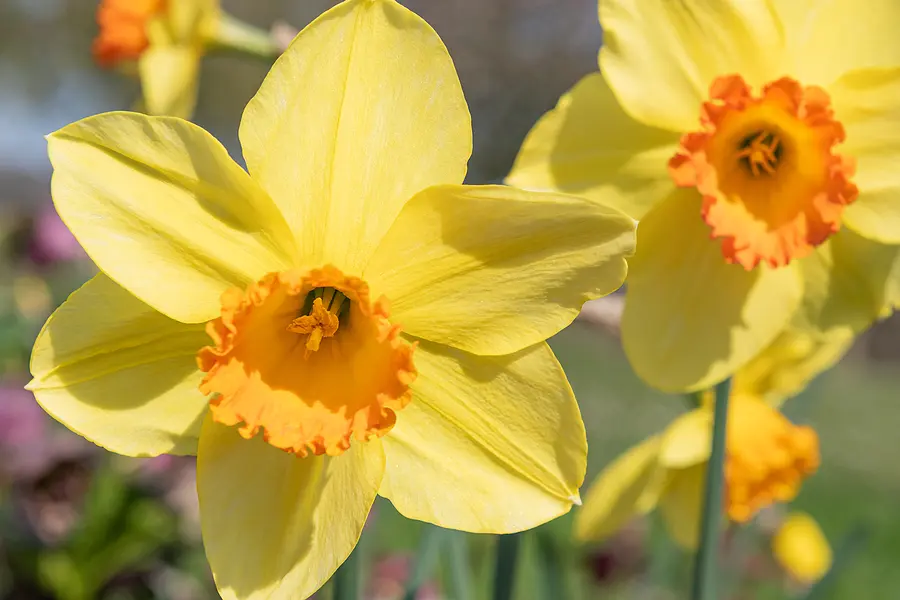How Do I Split My Perennials?

Dividing perennials is great to keep your plants healthy, and you also get more free plants! Discover when and how to dig up and transplant perennials.
Dividing perennials is good for the health of your plants and provides plenty more to share.
It’s only in gardening that dividing actually means multiplying. We are speaking of dividing perennial plants — digging up clumps of overgrown perennials and splitting them into smaller individual plants.
Why You Should Divide Perennials
When you divide your perennials, you end up with a greater number of plants that offer either more material to place around your own landscape and garden spaces, or more for sharing — as gifts or to swap with your trading partners in the neighborhood.
This is a fun way to grow new plants for yourself or in which to gift friends. Some fast-growers are so prolific that you may find yourself needing to pitch the excess into the compost bin.
Of course, that’s not the only positive result from dividing perennial plants. The biggest benefit of dividing perennials is that most plants will remain healthy and look their best. Not all perennials and grasses need to be divided, but the process can help revitalize plants that have become overgrown and sometimes encourage them to produce more blooms.
Perennials require dividing, digging and transplanting in order to ensure healthy blooming. If the center of a plant dies out or resembles a doughnut, or if it starts to flop, stops flowering or outgrows its spot, it’s time to divide.
When to Divide Perennials
They’re often so obviously ready for a breakup. You’ll know it’s time to divide when you notice your plant beginning to die in the middle — that is, as the plant grows, it’s actually getting itself too crowded even for its own good.
Other symptoms might be reduced flowering and overall poor performance. And the tumor can be fairly large.” By Stephen Westerholm Make sure you’re not making these other common mistakes with perennials.
An old proverb to use as a guide is: “Divide spring bloomers in fall, fall bloomers in spring, and summer bloomers in either fall or spring.” To ensure great success, dig up and begin dividing/transplanting your spring blooming perennials in late summer, fall bloomers in early spring)and those that flower midseason at ) either time. Experienced gardeners know that dividing perennials plants can be pushed to an extreme when time allows. With most perennials, you can bend the transplanting guideline if you give them good care afterward.
Water well and regularly enough to maintain slightly moist roots. Increase time between watering as plantings become established. Once they’re established, treat them as you previously would have.
Some plants can be divided at any time, such as daylilies, but be certain that you divide perennials sooner than a month before the ground freezes. Find out what other garden tasks you should be doing in the fall.
How to Divide Perennials
Dig up the plant you’re splitting with a spade or fork on a cool, cloudy day.
Lift the plant out, shake loose soil from roots and tease them apart. And cut the plant into smaller divisions, ensuring that each has growing shoots and roots.
Because the perennials that have finer roots are easier to separate. Plants such as yarrow, aster, coreopsis, monarda and sedum are easily cut in half with a spade. Larger ornamental grasses are trickier. Although the larger or deeper the root system, the harder dividing can be from just a physical banging and hacking apart perspective.
To reduce stress on the plant, it’s a good idea to dig holes for daughter divisions before you extract the mother growing point. That could significantly shorten the amount of time your plant has to be out of the ground with its roots exposed.
Plants should also be pruned to allow for losses of roots. Roots suck up moisture for the plants, while leaves give off moisture as they breathe. Trim the foliage to reduce stress on the roots and to encourage your new plants to grow.
Step 1:
Insert a garden fork or shovel around the outside edge of the entire plant, dig and pull it from the ground.
Step 2:
You will cut each plant in half, quarters or eighths depending on its size and how many you want. Two garden forks or shovels, held back-to-back, can often break up a clump of roots that’s being stubborn.
Step 3:
Incorporate 2 to 3 pounds of a slow-release nitrogen fertilizer and organic matter into the planting sites. This is one of very few opportunities that you have to make a real difference in the soil around your perennial plants.
Step 4:
Re-plant divisions at their original planting depth. You might need to push one of the divisions back into its original position. But do not replant the center of the plant if it has dried-out or died. That’s more for the compost bin. Water thoroughly.
